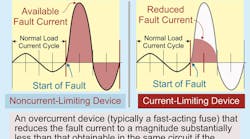Q. What does the Code mean by “overcurrent”?
A. Overcurrent exists when current exceeds the rating of equipment or the ampacity of a conductor, due to an overload, short circuit, or ground fault. The Code defines these three terms in Art. 100 as follows:
• Overload. An overload is a condition where equipment or conductors carry current exceeding their current rating. A fault, such as a short circuit or ground fault, isn’t an overload. An example of an overload is plugging two 12.50A (1,500W) hair dryers into a 20A branch circuit.
• Short circuit. A short circuit is the unintentional electrical connection between any two normally current-carrying conductors of an electrical circuit, either line-to-line or line-to-neutral.
• Ground fault. A ground fault is an unintentional, electrically conducting connection between an ungrounded conductor of an electrical circuit and the normally noncurrent-carrying conductors, metallic enclosures, metallic raceways, metallic equipment, or the earth. During the period of a ground fault, dangerous voltages will be present on metal parts until the circuit overcurrent device opens.
Overcurrent devices protect conductors and equipment. Selecting the proper overcurrent protection for a specific circuit can become more complicated than it sounds. The general rule for overcurrent protection is that conductors must be protected in accordance with their ampacities at the point where they receive their supply [240.4 and 240.21]. However, there are many special cases that deviate from this basic rule, such as the overcurrent protection limitations for small conductors [240.4(D)] and the rules for specific conductor applications found in other Articles, as listed in Table 240.4(G). There are also a number of rules allowing tap conductors in specific situations [240.21(B)]. Article 240 even has limits on where overcurrent devices are allowed to be located [240.24].
An overcurrent protection device must be capable of opening a circuit when an overcurrent situation occurs, and must also have an interrupting rating sufficient to avoid damage in fault conditions [110.9]. Carefully studying the provisions of this Article will help you provide sufficient overcurrent protection in the correct location.
Article 240 covers the general requirements for overcurrent protection and the installation requirements of overcurrent devices.
240.1 Informational Note: An overcurrent device protects the circuit by opening the device when the current reaches a value that’ll cause excessive or dangerous temperature rise (overheating) in conductors. Overcurrent devices must have an interrupting rating sufficient for the maximum possible fault current available on the line-side terminals of the equipment [110.9] (Figure). Electrical equipment must have a short-circuit current rating that permits the circuit’s overcurrent device to clear short circuits or ground faults without extensive damage to the circuit’s electrical components [110.10].
Q. What does the Code recognize as standard ampere ratings for overcurrent protection devices?
A. The standard ratings in amperes for fuses and inverse time breakers are: 15, 20, 25, 30, 35, 40, 45, 50, 60, 70, 80, 90, 100, 110, 125, 150, 175, 200, 225, 250, 300, 350, 400, 450, 500, 600, 700, 800, 1,000, 1,200, 1,600, 2,000, 2,500, 3,000, 4,000, 5,000 and 6,000 [240.6(A)] .
Additional standard ampere ratings for fuses include 1, 3, 6, 10, and 601.
Fuses rated less than 15A are sometimes required for the protection of fractional horsepower motor circuits [430.52], motor control circuits [430.72], small transformers [450.3(B)], and remote-control circuit conductors [725.43].
The ampere rating of an adjustable circuit breaker is equal to its maximum long-time pickup current setting.
The ampere rating of adjustable-trip circuit breakers that have restricted access to the adjusting means is equal to their adjusted long-time pickup current settings.
These materials are provided to us by Mike Holt Enterprises in Leesburg, Fla. To view Code training materials offered by this company, visit www.mikeholt.com/code






